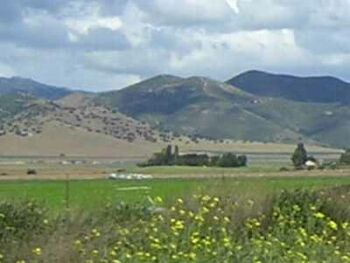
Publisher:
Bonnie King
CONTACT:
Newsroom@Salem-news.com
Advertising:
Adsales@Salem-news.com

~Truth~
~Justice~
~Peace~
TJP
Mar-14-2007 05:20

 TweetFollow @OregonNews
TweetFollow @OregonNews
Report: Disease Opened Door to Invading Species in California, Pacific Northwest
Salem-News.comAbout 50,000 exotic species have been introduced into the United States.
 Salem-News.com |
(CORVALLIS) - Plant and animal diseases can play a major and poorly appreciated role in allowing the invasion of exotic species, which in turn often threatens biodiversity, ecological function and the world economy, researchers say in a new report.
In particular, a plant pathogen appears to have opened the gate for the successful invasion of non-native grasses into much of California, one of the world's largest documented cases of invading species and one that dramatically changed the history and ecology of a vast grassland ecosystem.
The study, published today in Proceedings of the National Academy of Sciences, a professional journal, should improve the understanding of invasive species and possibly suggest new tools to combat them, said researchers at Oregon State University.
"Even if we can't control all the diseases that help species invade, at least now we know to consider diseases when studying invasion," said Elizabeth Borer, an assistant professor of zoology at OSU. "In analyzing the ecology of exotic plant or animal species, it's clear that diseases are one part of the equation."
About 50,000 exotic species have been introduced into the United States, and the havoc they wreak upon agricultural crops, wildlife, ranch animals, forests and grasslands costs about $137 billion a year, scientists say.
Invading species are also responsible for about half of all native species that go extinct, studies show.
One of the primary theories of successful invading species, experts say, until now had been the "enemy release hypothesis," in which an invasive species is no longer constrained by whatever predators or control mechanisms kept it in check in its native habitat.
The new study, however, suggests diseases that are native to a region, or imported along with invasive species, may also play a key role in whether or not the invader becomes a significant problem.
In the case of California, some of the first Spanish settlers in the 1600s and 1700s brought with them cattle, grazing, and new annual grasses that, even though they appeared to be inferior competitors, rapidly displaced native perennial grasses in California and also parts of the Pacific Northwest.
"The complete change in grassland ecosystems brought with it more damaging fire regimes, shorter grazing seasons, and altered water and carbon cycles" said Eric Seabloom, an OSU assistant professor of zoology and co-author of the study. "Annual grasses like wild oats, barley, and ripgut brome helped to damage what had been one of the richest and most diverse plant communities in the world."
What the OSU researchers found, however, was that the invading grasses might never have become dominant were it not for a plant pathogen called barley yellow dwarf virus, which reduces plant growth, lowers seed production and increases mortality.
In the absence of this pathogen, the native plants would have been able to rebuff the invaders and persist, rather than being overtaken, the study concluded.
"Not only were the native grasses under constant challenge from this disease, but the characteristics of the new grasses helped to spread the disease much more efficiently," Borer said. "It just beat them down, and they were not able to compete successfully."
This virus had been in the native California grasses for a long time, the scientists said, but when the annual grasses were added to the mix, they changed the infection rates in the native perennial grasses.
The higher infection rate in the natives probably allowed the annuals to invade and take over this vast grassland.
The research was conducted with a $1.8 million grant from the National Science Foundation, under the Ecology of Infectious Disease grant program, and in collaboration with scientists at Princeton University.
This is the first study to quantitatively demonstrate that an existing pathogen could have allowed exotic species to invade where they would not have invaded in the absence of the pathogen, the researchers said.
Knowledge of this phenomenon may be important to understanding past invasions and predicting or controlling future ones, they said.
Identification of this virus as a key to the loss of native plants may not aid in their recovery, because it's very difficult to breed disease resistance to this plant pathogen.
But in other situations where diseases are opening the door to invading species, there may be opportunities for intervention when this process is better understood, scientists said.
Articles for March 13, 2007 | Articles for March 14, 2007 | Articles for March 15, 2007

Quick Links
DINING
Willamette UniversityGoudy Commons Cafe
Dine on the Queen
Willamette Queen Sternwheeler
MUST SEE SALEM
Oregon Capitol ToursCapitol History Gateway
Willamette River Ride
Willamette Queen Sternwheeler
Historic Home Tours:
Deepwood Museum
The Bush House
Gaiety Hollow Garden
AUCTIONS - APPRAISALS
Auction Masters & AppraisalsCONSTRUCTION SERVICES
Roofing and ContractingSheridan, Ore.
ONLINE SHOPPING
Special Occasion DressesAdvertise with Salem-News
Contact:AdSales@Salem-News.com
Salem-News.com:

googlec507860f6901db00.html

Terms of Service | Privacy Policy
All comments and messages are approved by people and self promotional links or unacceptable comments are denied.
[Return to Top]
©2026 Salem-News.com. All opinions expressed in this article are those of the author and do not necessarily reflect those of Salem-News.com.